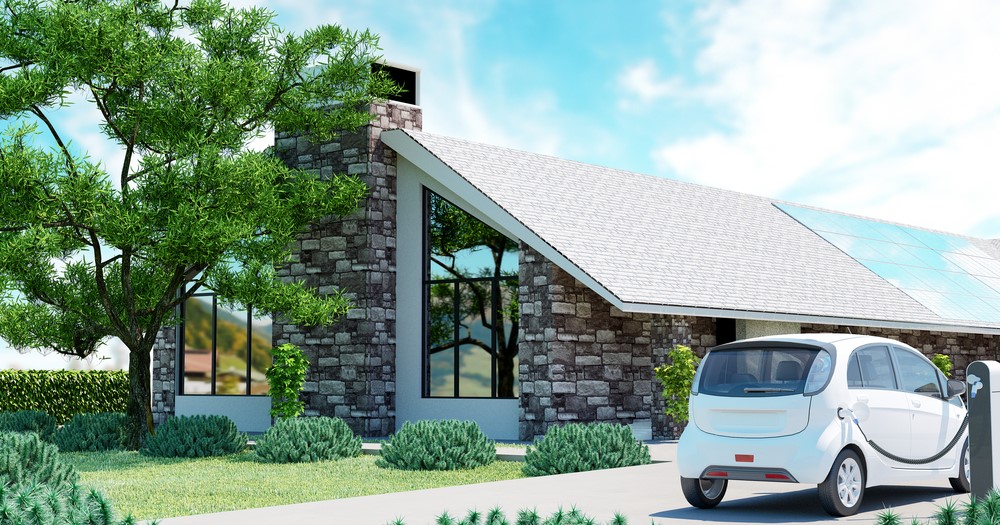Modern houses house modern vehicles, which is why more homes are modernizing by getting ready for electric cars. The good news: almost every house is already EV-ready. The better news: for relatively little money, the right equipment can make owning an electric car easier, cheaper, and a great time-saver over a car powered by gas. Technical details are important, but so is style.
Owning an electric car means not having to plan a trip around stopping at the gas station or shopping for the best price. Charge up at home and there’s no more need to play dodge-em as people maneuver around the pumps. Every trip can start as well-prepared as possible.
Level 1
If a house is on the electrical grid, it’s probably capable of providing the very thing every electric car needs, electricity. At the most basic level, any standard electrical outlet is sufficient to power an electric vehicle (an EV). Car manufacturers were smart enough to make sure that 110/120 volts was enough to recharge the batteries. Car manufacturers were also smart enough to build the chargers into the car. Converting the power from AC to DC happens inside the vehicle, not necessarily in some box on a wall, or in some pedestal beside the curb.
This simple solution is handy, especially when needing to charge up at work; but it does take patience. Every car is different; but in general, simply plugging an EV into a wall outlet charges the battery at about 4 miles of range per hour. That’s enough for short commutes or the smaller batteries in some hybrids; but it may take more than two days for EVs with the biggest batteries and the greatest ranges. That’s why most of the talk is about Level 2 EVSE (Electric Vehicle Supply Equipment).
Level 2
Here’s where some people get a little intimidated, because an EVSE sounds like something futuristic. They may look futuristic, but they’re basically an electrical and electronic box that sits between the house’s wiring and the car’s battery. An EVSE makes sure the electricity flows safely into the battery without overcharging it. The primary advantage for an owner is that the Level 2 EVSE charges the EV much more quickly. Instead of 4 miles of range per hour, the car charges up at about 11 to 22 miles per hour.
The EVSE helps control the load, but the real difference for Level 2 is that it takes advantage of a 240V 50 amp outlet, not the standard 110/120V. The extra outlet is a good reason to hire an electrician; but the job is nearly the same as installing an outlet for an electric clothes dryer. The total cost is normally less than a thousand dollars including the EVSE. Some people choose a more complicated unit that is hardwired into the wiring, but it is far easier to install an outlet and mount the EVSE beside it. That way, if there’s a reason to move or replace the EVSE, simply unplug it.

Level 3 & 4
More power! A faster charge isn’t always a luxury. Sometimes it is a necessity. A trip can drain a battery, but there may be more trips to make. Waiting overnight may not be an option In that case, Level 3 and above are there to charge at rates of as much as 100 miles of range per hour. These higher levels aren’t as simple because the direct chargers are more likely to use direct current, and manufacturers haven’t agreed on a standard. They’re available, but check with the car’s manufacturer.
Level X
Level X isn’t one thing. It is many things. Electric cars are evolving, so is their infrastructure. Faster, easier chargers are inevitable. Innovations like swapping batteries in less than a couple of minutes have already been demonstrated. Variations like carports with solar roofs exist. And, of course, the simplest (but not the cheapest) solution is to have two EVs, one that’s in use and one that’s being charged.
Style
Electric Vehicles are changing modern homes.
It is easy to think about having a charging station installed; but it may make more sense to install a few. Households with more than one EV may want more than one station. Guests may drop by and need to fill up before they head home. Compared to other home improvements, installing multiple charging stations can be reasonable.
The electrical details of adding one or several stations may only be limited by time and the house’s amperage; but making it look good and work well can be a job for the right architect and contractor.
Installing one or two in a garage makes a lot of sense and doesn’t take up much room. Doing so outside makes it easier for guests, and becomes an opportunity to exercise creativity and innovative design while respecting the landscaping. A series of pedestals, like those used in urban charging stations may be efficient and easy; but the equipment and cables can be housed in ways that don’t intrude upon the architecture.
Every house can find a different solution, and modern homes are exploring those possibilities now. (Eventually, someone will take an old gas pump and put a charging station inside.)
Looking Ahead
Electric cars were invented a hundred years ago, but now they are entering our lives and redefining our homes. Their evolution is accelerating. Today’s solutions will be replaced and upgraded within years, if not months. It is a time for flexibility, innovation, and adaptation. What will we think of next? A parking space for an autonomous taxi?


